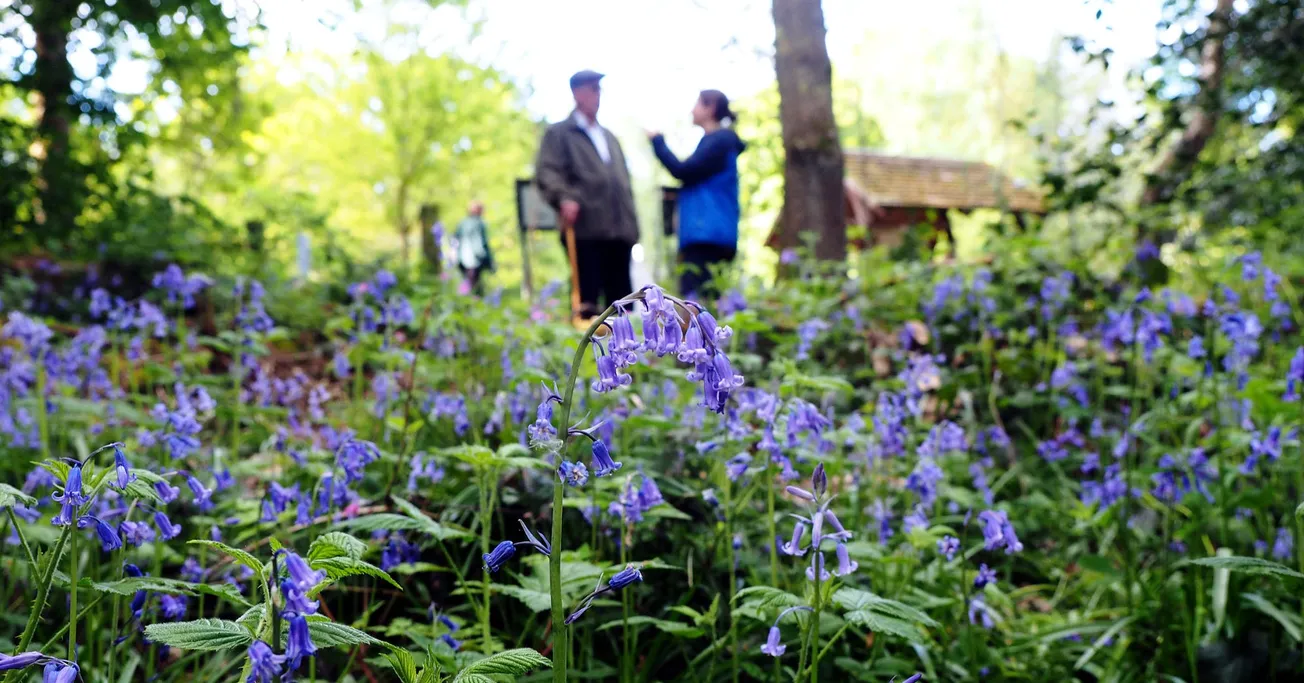One of our city’s showiest spectacles of spring has started this week. Veteran woodland wanderers know what to do: catch the tram to Meadowhall interchange, walk 15 minutes to Woolley Wood playground at Wincobank and off you go. It’ll take you less than an hour to stroll to the other end of what some say is the best bluebell wood in the country.
This is a subject of local debate, however. With 80 or more ancient woodlands around the city, we’re rich in amazing bluebell woods here.
At Woolley Wood, the banks of shimmering flowers rising up the hillside towards Shiregreen look purple, pale blue or even turquoise-grey depending on how the light falls. Writers and photographers try and fail to capture what a deep old bluebell wood really feels like: a carpet of blue? Not quite. Rippling pools among the green breezes of spring? Maybe.

Some observers prefer the patchier and more subtle bluebells of Ladies Spring or Roe Wood, or the quieter displays in the Moss Valley, Grenoside or Gleadless. Since the uninitiated bluebell hunter always heads to Ecclesall Woods first, staff there have taken to erecting branch or dead hedge barriers to deter photographers from trampling down the flowers before they get a chance to bloom properly.
I was lucky enough to visit Woolley Wood once with the city’s learned woodland raconteur, Professor Melvyn Jones, who sadly passed away three years ago. He told me that the name Woolley means ‘woodland clearing frequented by wolves,’ and the last mention of wolves in the area was a record of a set of pits dug to catch them in the 1300s.
The sloping site of Woolley Wood, on the parish boundary between Ecclesfield and Kimberworth, along with the variety of ancient woodland indicator flowers there (including bluebell) suggest that the wood is not just an official ancient woodland (likely to have been wooded from the 1600s or earlier). It’s probably what those in the woodland trade call a ‘primary wood,’ said Mel, a remnant of the original wildwood that stretched across the country at the end of the last ice age.

“A primary wood is the oldest thing in every parish,” he said. “If it is a primary wood, Woolley Wood has been here for 10,000 years.” Think of that this spring as you flash past those flecks of blue on the train to Leeds or Chapeltown.
Ancient woodland indicator plants are flora that suggest a woodland could have been around before the 1600s. They don’t generally prove that date on their own, but several plants existing together at the same site usually provide a conclusive case for an ancient woodland designation.
The flower in Woolley Wood, and deep inside most of our other ancient woodlands, is properly called the Common, or English, Bluebell. But creeping around on our woodland edges are a set of gaudier invaders from Spain, and their offspring. The Spanish bluebell is a garden plant, and can be pink or white as well as bright blue. Five years ago, Sheffield & Rotherham Wildlife Trust carried out a series of surveys in a selection of our ancient woodlands to map the encroaching Spanish invaders, along with the hybrids created when the Spanish and English bluebells are cross pollinated.

At the time, there were horror stories suggesting the native flowers beloved by poets were being wiped out by piles of garden rubbish containing the bulbs and seeds of Spanish bluebells, which were then setting out to invade our ancient woodlands.
But the transects mapping the extent of the bright blue Spaniards and their hybrids showed that in fact, the hybrids were clustered in very small urban woodlands, or at woodland edges, often in known garden flytipping sites. (Where gardeners had unthinkingly thrown their unwanted bluebells over the garden fence into the old woodland beyond their borders, was how I heard one ecologist explain it to me.)
David Botcherby is a botanist working with Sheffield & Rotherham Wildlife Trust on mapping our ancient woodlands, while Gerry Firkins is another expert local botanist working with Sorby Natural History Society and the Groves Nature Watch Group near Broomhall. I asked them about the flower xenophobia sweeping the nation — namely, the concern that the English Bluebell might be overrun by Spanish invaders.

“People were saying, oh the woods are getting infected with the foreigners and they'll never recover, or it’ll just get worse and worse, and it's all over and how terrible things are,” says Gerry. “But that's not quite true, it turns out now, because it seems the natives are more fertile. It's as simple as that.”
It seems the hybrid bluebells don’t produce as many seeds as the prolific English variety, or more of the invading seeds are infertile, possibly after years of selective breeding for garden plants.
“The hybrid doesn’t seem to spread very far into woods,” says David Botcherby. “Where it breeds with the natives you get a sort of a gradient of hybrids from where you get introductions of the Spanish bluebell. “It doesn't stop them from still spreading some non-native genes into the native bluebell gene pool, but it doesn't seem like we're going to end up losing the English bluebell.”

Nevertheless, we should certainly not dump our garden waste anywhere near our ancient woodlands, say Sheffield and Rotherham Wildlife Trust. Diseases from imported plants are a risk as well as mixing genes with native flora. And it’s also much easier to source native bluebells for your own wildlife garden too, so why plant imported non-native bluebells anyway? And although the Spanish bluebell might struggle to spread its seed, it does grow more vigorously and can outcompete native flowers in the short term.
David tries to explain the difference if you want to try and spot the hesitant incursions at our woodland edges:
“The English one sort of droops to one side, and the bells are smaller and darker blue generally, and the individual bells are bigger on the Spanish one, and more showy and they're often a lighter purple or pinkish. But the main thing is that the Spanish bells are all round the stem, rather than leaning over in that classic English bluebell way.”

The hybrids are a bit of a mixture. In some places, I’m told, you can look in the same place and see characteristics of the droopy English variety returning year by year.
Gerry explains how the bluebell spreads, slowly and steadily in our eyes, but actually pretty quickly in woodland years. The stem stiffens later in spring so seeds are just slightly sprung away from the parent plant in a breeze, maybe spreading not much more than a foot or so a year. But the seeds are also spread by passing animals, often on their feet. When bluebells were making the most of our old wildwoods, there were big wild beasts under Wincobank hill, like bison, aurochs and wild boar as well as wolves, which all trampled over the bluebells and spread them up and along the hillsides. Nowadays, humans do the same, says Gerry.
But when we see a random clump of bluebells on a council estate path-side, or a field hedgerow, it can also tell us there was a woodland there in the not so distant past. And in some cases, if the light and soil are right, bluebells can gradually creep into younger woodland from their older home woods, as they seem to be doing now in places like Graves Park.

Britain is home to half of the world’s common bluebells (proper name Hyacinthoides non-scripta), Gerry adds, and Sheffield has a unique position for the appreciation of the English bluebell, because there’s an ancient woodland near virtually all of us.
The steep valleys alongside our working rivers provided sustainable wood to fuel our growing metal industries, where woodworkers coppiced trees for generations. Coppicing is a very old, but still-practised craft, by which skilled woodworkers select certain branches or stems to cut down and use, while leaving the main tree growing for more fuel, or wood products like poles or stakes, in years to come.
The way bluebells bloom suggests just how practical nature can be. Bluebells flower early enough in the season to catch some sunlight before the tree canopy closes in mid-summer. Like Goldilocks breaking into the three bears’ home, they like things just right: soil which isn’t too wet or too dry, but a midpoint. This makes our city region a natural haven for them, since Sheffield’s ancient steep sided former coppice woods provide plenty of damp (but not too damp) soil.

So unlike spectacular rural bluebell woods around the country, some of our best bluebell woods are in very urban locations: the Gleadless Valley, the woods of Graves Park, Woolley Wood, for example, and after his researches over the last year or two, David Botcherby suggests a handful of lesser known urban bluebell woods: Stoneley Wood near Charnock, Nor Wood near Killamarsh, and Low Hall Wood near Burncross.
“We've got more access to bluebells just because we've got all these ancient woods,” he says, "and that's one of the treasures of Sheffield.”
It’s not just the colour, it’s the smell, said Nicky Rivers from the Wildlife Trust. “Native bluebells have a sweet smell, I think, whereas Spanish Bluebells barely smell at all,” she told me.

When he was young, Gerry Firkins tells me he’d go out and gather bluebells for the small stately home where his mum worked, because the mistress of the house wanted the smell of bluebells for her guests.
You should never do it now of course, he says. “But back then we’d gather big armfuls from the wood nearby to bring into the house just to have the smell for one day, because they wilt and go horrid very quickly. So now it’s nice to go and stand in the middle of a bluebell patch and have a good sniff, because it takes me right back to being a child.”
So go visit. If you’re an urbanite not prone to reading Emily Bronte on the joys of spring bluebells, you have a window of about two to three weeks to go see what she meant by the ‘sweetest flower’ — you’ll probably have an ancient woodland nearby. Just look for the hill and smell the breeze.

Comments
How to comment:
If you are already a member,
click here to sign in
and leave a comment.
If you aren't a member,
sign up here
to be able to leave a comment.
To add your photo, click here to create a profile on Gravatar.







